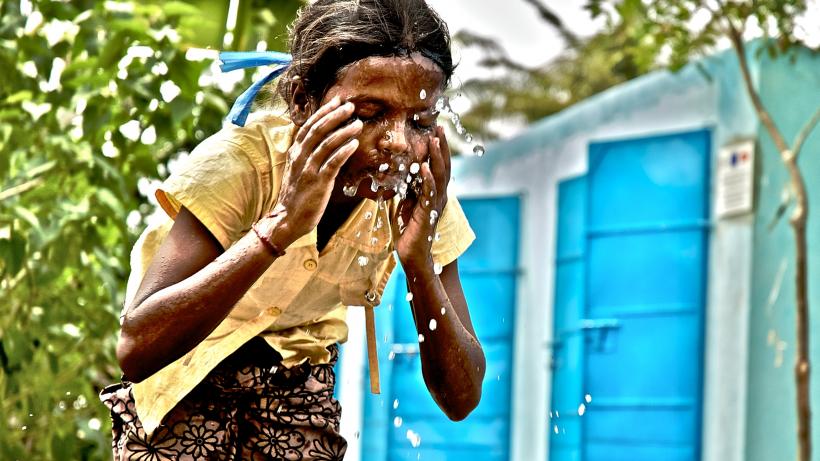
Demons of density: Delivering water and sanitation to the poor
As rates of urbanisation continue to grow, particularly in the developing world, so does the challenge of overcoming barriers to clean water and sanitation. This problem is particularly acute for the growing numbers of urban migrants that move into expanding informal housing settlements, or slums. Despite high initial costs for infrastructure investments, expected returns from expanding access to water and sanitation provide a strong economic justification for investing in infrastructure.
Over 1.5 million cases of infant mortality are caused each year by a lack of clean water and good sanitation. Worldwide, over 700 million people lack access to clean water sources, and 2.5 billion (or one-third of the total population) lacks access to improved sanitation facilities. Experts predict improvements in drinking-water, sanitation, hygiene, and water resource management could prevent 10% of the worldwide total disease burden. Access to clean water and sanitation has also been adopted as the 6th new Sustainable Development Goal.
Addressing gaps in service delivery and access will require policymakers to prioritise water and sanitation infrastructure in cities across the developing world.
A city of one million people discharges an estimated 1,500 cubic metres of waste daily – a mammoth task for local management. It might be expected that denser urban populations lead to increased water and sanitation problems. But in fact, people living in urban areas have better access to services. In 2010, UNWater stated that 96% of the worldwide urban population had access to improved sources of drinking water, versus 81% of the rural population. Similarly, in sanitation, 79% of the urban population have access versus 47% of the rural population.
These same positive differences hold for the 14 IGC partner countries:


Progress on water and sanitation is not keeping up with the rapid pace of urbanisation.
A city of one million people discharges an estimated 1500 cubic metres of waste, daily.
In absolute terms, the number of people in urban areas without access to improved drinking water sources or improved sanitation facilities actually increased between 1990 and 2012. This alarming statistic is primarily due to the increase in the number of slum residents – expected to reach nearly 900 million by 2020. The majority of informal residences have no running water and use pit-latrines. While bore-holes or wells are occasionally provided by governments and or private operators, are typically rudimentary and poorly maintained.
So why aren’t countries investing in improving water and sanitation infrastructure? The barrier seems largely to be the expense. Conventional sewerage systems require vast initial investments as well as ongoing operational and maintenance costs. Universal access to improved water and sanitation facilities would cost around US$22.6 billion per year.
Despite high initial costs, universal access could produce considerable returns. For every US$1 spent on water and sanitation infrastructure, the WHO estimates returns ranging from US$5- 28, primarily through gains on time saving on activities (e.g. gathering water) and the remainder from a reduction in water borne diseases. Economic benefits are estimated at ~US$84 billion.
Cities are centres of innovation, this power could be harnessed for the provision of more sustainable water and sanitation infrastructure. The following examples, selected from India and Uganda, showcase some innovative research currently being conducted to address this problem:
Delhi, India
By 2017, 104 million people will live in Indian slums – or around 9% of the total projected national population. Today, a quarter of Delhi’s population (c. 18 million) live in informal settlements, a consequence of massive internal rural to urban migration. Given the existing challenge of keeping pace with demand for basic provision at current population levels. Expected urban growth poses a significant challenge. Failure to solve these issues is not only a problem of human deprivation but may be contributing to India’s slow urbanisation rate to date. In particular, improvements and investments in water and sanitation infrastructure are desperately needed.
To analyse how these investments affect the health of slum dwellers, the IGC surveyed Delhi slum inhabitants in 2012. We found a significant association between the quality of toilet and garbage facilities and childhood nutrition. Families living near a clean public toilet, with hand-washing facilities and without human waste, have better-nourished children. Furthermore, households with some form of trash collection have even greater nutritional outcomes. This research underscores the need for local governments to invest heavily in the quality and cleanliness of local facilities, given the significant impact they have on the health of Indian children.
Kampala, Uganda
Every day, workers flood from the surrounding towns and villages into the bustling capital city of Kampala, already home to two-thirds of Uganda’s urban population. These movements have put enormous pressure on the Kampala Capital City Authority (KCCA) to improve the coverage of sanitation infrastructure – currently hovering at around 10% of the urban population. This is particularly difficult when up to 70% of the city population lives in informal housing. The main problem in Kampala is not open defecation but what to do once the latrine is full. One enterprise that is attempting to remedy this problem is the Sanitation Solutions Group; a business providing sanitation to houses by constructing latrines and providing a privately-contracted service of latrine-pit-emptying.
Their main issue is that while demand for latrines is large, willingness-to-pay is low. Pin-pointing the reason for this is difficult. The size of the initial investment may be putting people off, particularly if they discount the future value of health improvements from latrines. Alternatively, the problem may simply be one of limited awareness. Households may not be aware of the full range of benefits from improved sanitation.
Areas with better sanitation usually have higher incomes. This may in part be a self-reinforcing difference as households with better health outcomes lose less days to illness and therefore are likely to be more productive. We need to investigate how to get urban residents and policy stakeholders to internalise these benefits and invest more in improving Kampala’s sanitation infrastructure, an issue that the Sanitation's Solutions Group and the Kampala Capital City Authority are investigating.
Next steps
Progress on providing water and sanitation infrastructure is not keeping pace with the rapid urbanisation rate in the world’s poorest countries. Without these investments, deaths from malnutrition and disease, especially in children will continue to rise.
For every US$1 spent, the WHO estimates returns ranging from US $5-28, primarily through gains on time saving on activities (e.g. gathering water) and the remainder from a reduction in water borne diseases. Economic benefits are estimated at ~US $84 Billion
The problem is especially acute in the world’s poorest cities – where a higher proportion of the city’s population reside in informal housing with rudimentary water and sanitation infrastructure. Research on measuring the impact of water and sanitation infrastructure investments on health and livelihoods is ongoing. Learnings generated from this work should be used by policymaker seeking to prioritise investments in water and sanitation.
To learn more about the challenges facing developing cities, stay tuned for the next post in our on #BuildingCities, which looks at the role of data in solving traffic congestion in Dhaka, Bangladesh.

